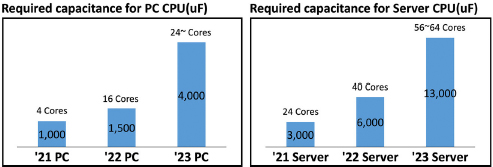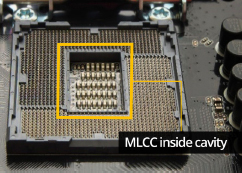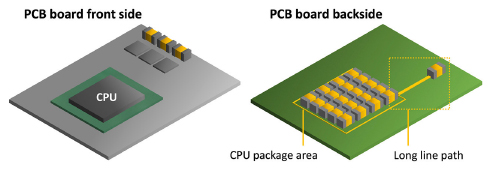FTM / Connectivity / Samsung Electro-Mechanics — Automotive MLCCs


Vehicles equipped with advanced driver assistance systems (ADAS) use various sensors and cameras to recognize the surrounding environment, thus enabling them to respond accordingly. To enable a vehicle moving at high speed to recognize objects and process data about them instantaneously, a processor for high-performance computing (HPC) must be used.
Multilayer ceramic capacitors (MLCCs) are widely used in automobiles to support HPC systems. The proportion of small and high-capacitance products in the voltage range 4 V to 6.3 V is rapidly increasing in line with the growth in the market supporting PCs and servers.
Samsung Electro-Mechanics supplies a number of ultra high-capacitance MLCCs which are AEC-Q200 qualified. They include 0603i (1608m) devices with a capacitance of 10 µF, and 0805i (2012m) with a capacitance of 22 µF. These capacitors have a maximum operating temperature of 125°C for use in automotive electronics.
HPC in automotive applications
Traditionally the requirements of MLCCs for automobiles are for high reliability, low capacitance, large size, or high voltage. This is because automotive MLCCs have been used for battery or voltage conversion, since high-performance processors that offer fast operation are not used. However, as the functions of ADAS have expanded beyond simple driver assistance to implement partially autonomous driving, a vehicle must be equipped with a high-performance processor that can process a large amount of sensor or image data in real time and make driving decisions.
An ADAS board configuration is generally simple: acquire data → decide → transmit driving data. Data collected through cameras, radar, and LiDAR is recognized as people, objects, or vehicles in an ADAS system-on-chip (SoC), as shown in Figure 1. After the ADAS system decides on the driving action which the situation requires, the decision data is transmitted to the powertrain.

Fig. 1: Typical architecture of an ADAS board
Here, a high clock speed and more cores are required because the ADAS SoC must analyze a large amount of high-resolution image data in a short time to make driving decisions. This leads to increased power consumption, requiring more MLCCs. This trend in automotive systems reflects that of PCs and servers, so the trend seen in MLCCs for HPC systems helps to predict the future of the MLCC in automotive electronics.
CPU for HPC in automotive
As a CPU adds cores and functions, the capacitance of the MLCC required by the CPU of a PC or server also substantially increases, as shown in Figure 2. In particular, as high-performance GPUs and various AI functions are integrated into CPUs, the required capacitance for MLCCs rapidly increases year-on-year.

Fig. 2: The requirement for capacitance to support the CPU in servers and PCs grows year-on-year
How to accommodate more MLCCs in a limited space
While the required capacitance of MLCCs keeps increasing, the space in which MLCCs can be accommodated grows more limited. And as CPU performance increases, CPU performance becomes more sensitive to external noise, and the further the MLCC is from the CPU, the greater the noise.

Fig. 3: Socket-mounted CPU and MLCC
For this reason, socket-type CPUs as found in a desktop PC or server position MLCCs by drilling cavities in the socket, shown in Figure 3. If the MLCC is soldered to a PCB without using the socket type due to restrictions such as thickness, or because there is no need to replace the CPU, the MLCC is placed on the back of the board facing the place where the CPU is surface-mounted, to keep it as close to the CPU as possible. As shown in Figure 4. However, the area available for an MLCC to be surface-mounted is limited.

Fig. 4: Decoupled mounting of CPU and MLCCs
Currently, the average MLCC capacitance as required by an ADAS SoC is around 2,000 µF, but judging from the HPC cases discussed above, the capacitance is expected to more than double within one or two years. This means twice as many MLCCs will be needed, and it is surprisingly easy to put more MLCCs in a limited space by adopting a smaller size.
To simplify the calculation, we will simply simulate the situation, focusing only on the chip size without considering the surface-mount spacing for parts. Currently, a typical ADAS SoC has an area of 576 mm² (24 mm x 24 mm). If two hundred 0805i (2012m), 10 µF units are used to realize a total capacitance of 2,000 µF, the MLCC footprint is 480 mm², allowing MLCC placement comfortably within the ADAS SoC package area.
Assuming that up to 4,000 µF in future to support the more powerful ADAS SoC of the future, the MLCC must be placed quite far from the SoC if the same 0805i (2012m), 10 µF products are used, as shown in Figure 5.

Fig. 5: Increased mounting area required as capacitance requirement grows
Small, ultra-high capacitance automotive MLCC from Samsung
To solve this problem, Samsung Electro-Mechanics has developed an 0603i (1608m), 10 µF, 6.3 V MLCC which is AEC-Q200 qualified, and can provide high capacitance in a smaller size. By using four hundred 0603i, 10 µF, 6.3V units to provide capacitance of 4,000 µF, the total MLCC area is reduced to 512 mm², which makes it possible to place the MLCCs close to the ADAS SoC without problems.
Furthermore, by also using 1210i (3225m), 100 µF products which are now in mass production, automotive manufacturers can meet the design’s requirement for 4,000 µF capacitance in an even smaller space. Additionally, if the smaller MLCC is used, the internal path gets shorter, to improve ESL, shown in Figure 6.

Fig. 6: MLCC in smaller package offers reduced ESL
Samsung Electro-Mechanics also mass-produces 0805i (2012m), 22 µF, 6.3 V and 1206i (3216m), 47 µF, 4 V MLCCs, showing that automotive manufacturers can depend on Samsung Electro-Mechanics to supply products for a wide variety of functional requirements.
Samsung Part Number | Case Size (mm) | Capacitance (Voltage Rating) | Temperature Rating |
CL10Z106MQ9VPNC | 0603i (1608m) | 10 µF (6.3 V) | X7T (125℃) |
CL21Z226MQYVPNE | 0805i (2012m) | 22 µF (6.3 V) | X7T (125℃) |
CL31Z476MRKVPNE | 1206i (3216m) | 47 µF (4 V) | X7T (125℃) |
CL32Z107MQV6PNE | 1210i (3225m) | 100 µF (6.3 V) | X7T (125℃) |
Share This

Get access to the latest product information, technical analysis, design notes and more